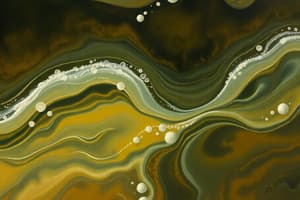Podcast
Questions and Answers
What does the flow rate Q represent in a pipe or artery?
What does the flow rate Q represent in a pipe or artery?
- The speed of the fluid flowing through the pipe
- The temperature of the fluid flowing through the pipe
- The pressure exerted by the fluid within the pipe
- The volume of fluid entering or leaving the pipe per unit time (correct)
What does the equation Q1 = Q2 represent?
What does the equation Q1 = Q2 represent?
- The conservation of energy in a fluid system
- The conservation of mass in fluid dynamics (correct)
- The relationship between fluid pressure and flow rate
- The relationship between fluid velocity and cross-sectional area
If the cross-sectional area of a pipe decreases, what happens to the fluid velocity?
If the cross-sectional area of a pipe decreases, what happens to the fluid velocity?
- The fluid velocity decreases proportionally
- The fluid velocity increases (correct)
- The fluid velocity becomes zero
- The fluid velocity remains constant
How is the volume of fluid leaving the tube over a time interval Δt expressed?
How is the volume of fluid leaving the tube over a time interval Δt expressed?
What does Bernoulli's equation indicate when fluid velocity increases in a segment of the pipe?
What does Bernoulli's equation indicate when fluid velocity increases in a segment of the pipe?
What does the first term in Bernoulli’s equation represent?
What does the first term in Bernoulli’s equation represent?
In the context of Bernoulli’s equation, what happens to the sum of the three energy terms in the absence of friction?
In the context of Bernoulli’s equation, what happens to the sum of the three energy terms in the absence of friction?
According to the principles of flow in a pipe, if fluid enters one end of a pipe, what must occur at the other end?
According to the principles of flow in a pipe, if fluid enters one end of a pipe, what must occur at the other end?
What is the unit of pressure mentioned in Bernoulli’s equation?
What is the unit of pressure mentioned in Bernoulli’s equation?
If blood is flowing at a velocity of 4 m/s and passes through a Venturi tube, at what point is its velocity likely to increase?
If blood is flowing at a velocity of 4 m/s and passes through a Venturi tube, at what point is its velocity likely to increase?
In which scenario is Bernoulli's equation applicable?
In which scenario is Bernoulli's equation applicable?
What does the equation derived from the law of energy conservation in fluid mechanics relate?
What does the equation derived from the law of energy conservation in fluid mechanics relate?
When a dam leaks at a height of 20 m, what kind of velocity will the fluid have as it emerges?
When a dam leaks at a height of 20 m, what kind of velocity will the fluid have as it emerges?
What is the acceleration due to pressure at rest when the pressure $P_H=13.2$ kPa and height $h=0.5$ m?
What is the acceleration due to pressure at rest when the pressure $P_H=13.2$ kPa and height $h=0.5$ m?
If the blood flow rate is 5 liters/min, what is the flow rate in cm³/sec?
If the blood flow rate is 5 liters/min, what is the flow rate in cm³/sec?
What condition allows Bernoulli's equation to be applied with minimal error?
What condition allows Bernoulli's equation to be applied with minimal error?
In a healthy individual, which values are considered high and low pressures respectively during blood flow?
In a healthy individual, which values are considered high and low pressures respectively during blood flow?
How is the total energy of blood per unit volume calculated at a systolic pressure of 120 torr?
How is the total energy of blood per unit volume calculated at a systolic pressure of 120 torr?
What is the Power $P_H$ produced by the heart if the flow rate $Q$ is 83.4 cm³/sec and total energy per unit volume is $1.63×10^5$ erg/cm³?
What is the Power $P_H$ produced by the heart if the flow rate $Q$ is 83.4 cm³/sec and total energy per unit volume is $1.63×10^5$ erg/cm³?
What is the relationship between the flow rate through a needle and its diameter?
What is the relationship between the flow rate through a needle and its diameter?
What is the acceleration relative to gravity ($g$) when the calculated acceleration $a = 25 m/s²$?
What is the acceleration relative to gravity ($g$) when the calculated acceleration $a = 25 m/s²$?
At what point does laminar flow transition to turbulent flow?
At what point does laminar flow transition to turbulent flow?
What factor affects the time taken for blood to be transfused through a needle?
What factor affects the time taken for blood to be transfused through a needle?
What is the gauge pressure of the blood within the vein during transfusion?
What is the gauge pressure of the blood within the vein during transfusion?
What is a characteristic feature of turbulent flow compared to laminar flow?
What is a characteristic feature of turbulent flow compared to laminar flow?
Which of the following measurements defines the pressure head for the transfusion scenario?
Which of the following measurements defines the pressure head for the transfusion scenario?
What is the critical flow velocity above which the flow in a cylindrical pipe becomes turbulent?
What is the critical flow velocity above which the flow in a cylindrical pipe becomes turbulent?
What does the Reynold's number (ℜ) indicate in fluid mechanics?
What does the Reynold's number (ℜ) indicate in fluid mechanics?
Which pressure gauge reading correctly reflects the relationship among heart pressure (PH), foot pressure (PF), and brain pressure (PB)?
Which pressure gauge reading correctly reflects the relationship among heart pressure (PH), foot pressure (PF), and brain pressure (PB)?
How does standing affect blood pressure readings in different parts of the body?
How does standing affect blood pressure readings in different parts of the body?
What is the effect of fluid flow turning turbulent compared to laminar flow?
What is the effect of fluid flow turning turbulent compared to laminar flow?
What happens to the pressures in the circulatory system when the heart pressure (PH) is measured standing compared to reclining?
What happens to the pressures in the circulatory system when the heart pressure (PH) is measured standing compared to reclining?
Using the given parameters, what is the computed pressure difference between foot pressure (PF) and heart pressure (PH)?
Using the given parameters, what is the computed pressure difference between foot pressure (PF) and heart pressure (PH)?
In discussions of the circulatory system, how is pressure conventionally measured?
In discussions of the circulatory system, how is pressure conventionally measured?
Flashcards are hidden until you start studying
Study Notes
Bernoulli's Equation
- Governs flow of incompressible fluids, linking velocity, pressure, and elevation.
- Formula includes terms for pressure (P), height (h), density (ρ), and velocity (v).
- First term: Potential energy per unit volume due to pressure.
- Second term: Gravitational potential energy per unit volume.
- Third term: Kinetic energy per unit volume.
- Based on energy conservation, the total energy remains constant without friction.
Continuity Equation
- Fluid volume flow rate remains constant in a pipe: Q1 = Q2.
- Flow rate (Q) calculates as Q = A × v, where A is cross-sectional area and v is velocity.
- Change in cross-section affects velocity: larger area results in lower velocity and vice versa.
Applications of Poiseuille's Law
- Blood flow characterized by high (120 mmHg) and low pressure (80 mmHg) during systolic and diastolic phases.
- For transfusions, pressures impact flow rate; higher pressure increases speed through smaller diameter tubing.
Turbulent vs. Laminar Flow
- Laminar flow occurs under critical velocity; exceeding this causes transition to turbulent flow.
- Turbulent flow leads to increased frictional forces and greater difficulty in fluid movement.
- Reynolds number (ℜ) helps identify flow type: values between 2000 and 3000 indicate turbulence.
Blood Flow and Pressure in the Body
- Heart pressures at different body parts (head, foot) measured in kilopascals (kPa) or torr.
- Height differences (h) in body parts affect pressure readings: pF - pH = ρghH.
- Normal pressures for healthy adults: high pressure (13.3 kPa), foot pressure (26.8 kPa), brain pressure (9.3 kPa).
Power Produced by the Heart
- Heart's energy generation maintains blood circulation.
- Power (PH) calculated as product of flow rate (Q) and energy per unit volume (E).
- Example calculations include kinetic energy from blood flow and energy from pressure contribute to total energy.
Example Challenges
- Blood velocity in a Venturi tube calculated using Bernoulli’s equation.
- Pressure head impacts transfusion rate via needle diameter and length.
- Governing equations for flow rates and pressures applied to realistic medical scenarios.
Studying That Suits You
Use AI to generate personalized quizzes and flashcards to suit your learning preferences.




